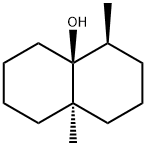GEOSMIN
- CAS NO.:19700-21-1
- Empirical Formula: C12H22O
- Molecular Weight: 182.3
- MDL number: MFCD00210292
- EINECS: 243-239-8
- SAFETY DATA SHEET (SDS)
- Update Date: 2023-05-25 18:01:12

What is GEOSMIN?
Description
Geosmin and other volatile compounds are produced by a variety of bacteria, cyanobacteria, algae, and fungi. They are responsible for some of the odors of water supplies and food sources. Odor production is greatest when nutrient production and dissolved oxygen are high.
Description
Geosmin is a natural bicyclic terpene with an earthy odor. According to The Merck Index, it is the “major volatile component of beet essence, also . . . the potent earthy odor contaminant of fish, beans, [and] water.” The human nose can detect it at concentrations in air as low as 5 ppt.
In 1936, A. C. Thaysen at the Chemical Research Laboratory, Teddington (London) described an odorous compound produced by actinobacteria in fishing streams. About 30 years later, Nancy N. Gerber and Hubert A. Lechevalier at Rutgers University (New Brunswick, NJ) isolated it from several Streptomyces spp. They did not determine its structure but named it geosmin from the Greek words for “earth” and “smell”. Biochemist Gerber later elucidated its structure.
Flash forward to 2019, when biologist Marcus C. Stensmyr and postdoc Nadia Melo at Lund University (Sweden) observed that yellowfever mosquitoes (Aedes aegypti) are attracted to geosmin. Their colleagues at Florida International University (University Park) showed that A. aegypti like the odor so much that they lay their eggs in geosmin baits.
Beet peels are rich in geosmin, so Stensmyr engaged a team at the Federal University of Alagoas (Maceió, Brazil) to construct and test a simple trap baited with beet-peel extract. This is a win–win situation because the peel is a waste product. Stensmyr’s next steps are to optimize the trap and observe whether it significantly decreases mosquito populations.
The Uses of GEOSMIN
Geosmin is an earthly odorant resposible for the strong scent (petrichor) that occurs in the air when rain falls after a dry spell of weather or when soil is disturbed.
The Uses of GEOSMIN
Geosmin is an earthly odorant responsible for the strong scent (petrichor) that occurs in the air when rain falls after a dry spell of weather or when soil is disturbed.
Definition
ChEBI: (-)-geosmin is the (-)-stereoisomer of geosmin, having 4S,4aS,8aR configuration. It is an enantiomer of a (+)-geosmin.
Properties of GEOSMIN
| Melting point: | 47 oc |
| Boiling point: | bp 270° |
| alpha | D25 -16.5° |
| Density | 0.985±0.06 g/cm3(Predicted) |
| storage temp. | -20°C |
| solubility | 160 mg/l (est.) |
| solubility | Chloroform (Slightly), Methanol (Slightly) |
| form | Oil |
| pka | 15.23±0.60(Predicted) |
| appearance | colorless solid or oil |
| color | Colourless |
| Odor | at 1.00 % in dipropylene glycol. fresh musty earthy soil |
| Odor Threshold | 0.0000065ppm |
| EPA Substance Registry System | 4a(2H)-Naphthalenol, octahydro-4,8a-dimethyl-, (4S,4aS,8aR)- (19700-21-1) |
Safety information for GEOSMIN
Computed Descriptors for GEOSMIN
Abamectin manufacturer
Aamirav Ingredients And Specialties Pvt Ltd
New Products
4-AMINO-TETRAHYDRO-PYRAN-4-CARBOXYLIC ACID HCL 4-(Dimethylamino)tetrahydro-2H-pyran-4-carbonitrile 4-AMINO-TETRAHYDRO-PYRAN-4-CARBOXYLIC ACID 4-Aminotetrahydropyran-4-carbonitrile Hydrochloride (R)-3-Aminobutanenitrile Hydrochloride 5-Bromo-2-nitropyridine Nimesulide BP Aceclofenac IP/BP/EP Diclofenac Sodium IP/BP/EP/USP Mefenamic Acid IP/BP/EP/USP Ornidazole IP Diclofenac Potassium 3-Bromopyrazole (3aR,4R,5R,6aS)-hexahydro-5-Triethyl silyloxy-4-((E)-3-oxo-5-phenylpent-1- enyl)cyclopenta[b]furan-2-one. 1-Chlorocarbonyl-4-piperidinopiperidine 1-Bromo-4-phenyl-2-Butanone 4-Amino-2-fluoro-N-methylbenzamide 1,1'-Carbonyldiimidazole SODIUM AAS SOLUTION ZINC AAS SOLUTION BUFFER SOLUTION PH 10.0(BORATE) GOOCH CRUCIBLE SINTERED AQUANIL 5 BERYLLIUM AAS SOLUTIONRelated products of tetrahydrofuran



![GEOSMIN [3H(G)]](https://img.chemicalbook.in/StructureFile/ChemBookStructure8/GIF/CB8418708.gif)




You may like
-
 19700-21-1 Geosmin 98%View Details
19700-21-1 Geosmin 98%View Details
19700-21-1 -
![Dimethyl [2-oxo-3-[3-(trifluoromethyl)phenoxy]propyl]phosphonate 99%](https://img.chemicalbook.in//Content/image/CP5.jpg) Dimethyl [2-oxo-3-[3-(trifluoromethyl)phenoxy]propyl]phosphonate 99%View Details
Dimethyl [2-oxo-3-[3-(trifluoromethyl)phenoxy]propyl]phosphonate 99%View Details
54094-19-8 -
 85-81-4 99%View Details
85-81-4 99%View Details
85-81-4 -
![208111-98-2 (3aR,4R,5R,6aS)-5-(Benzoyloxy)hexahydro-4-[(1E)-3-oxo-4-[3-(trifluoromethyl)phenoxy]-1-buten- 1-yl]-2H-cyclopenta[b]furan-2-one 99%](https://img.chemicalbook.in//Content/image/CP5.jpg) 208111-98-2 (3aR,4R,5R,6aS)-5-(Benzoyloxy)hexahydro-4-[(1E)-3-oxo-4-[3-(trifluoromethyl)phenoxy]-1-buten- 1-yl]-2H-cyclopenta[b]furan-2-one 99%View Details
208111-98-2 (3aR,4R,5R,6aS)-5-(Benzoyloxy)hexahydro-4-[(1E)-3-oxo-4-[3-(trifluoromethyl)phenoxy]-1-buten- 1-yl]-2H-cyclopenta[b]furan-2-one 99%View Details
208111-98-2 -
 2033-24-1 99%View Details
2033-24-1 99%View Details
2033-24-1 -
 Meldrums acid 2033-24-1 99%View Details
Meldrums acid 2033-24-1 99%View Details
2033-24-1 -
 Cyaclopentane carboxylic acid 99%View Details
Cyaclopentane carboxylic acid 99%View Details
3400-45-1 -
 2-Aminopyridine 504-29-0 99%View Details
2-Aminopyridine 504-29-0 99%View Details
504-29-0